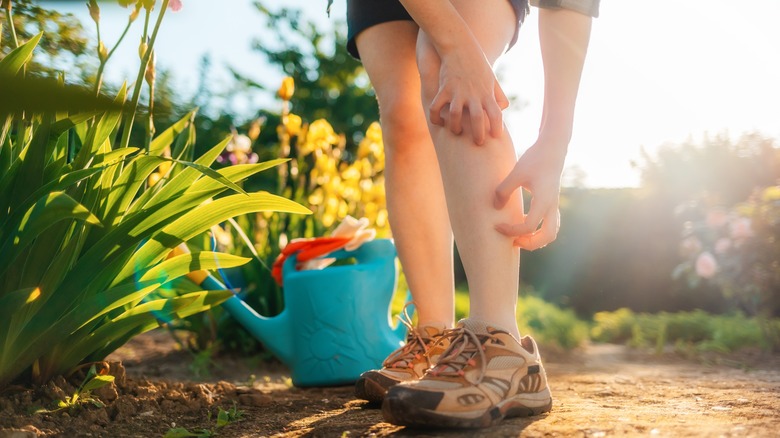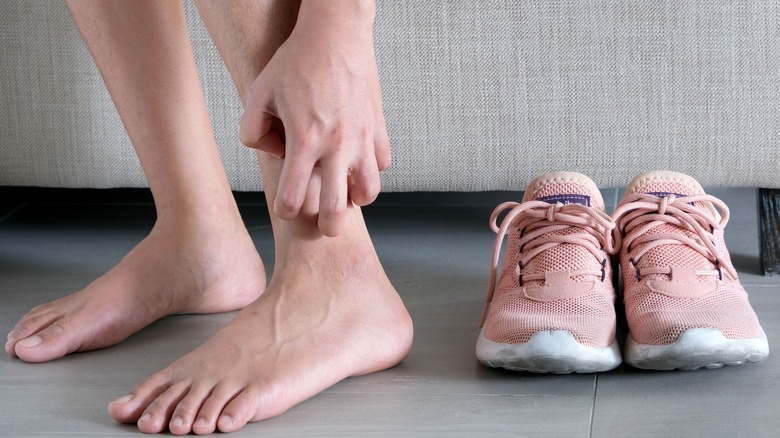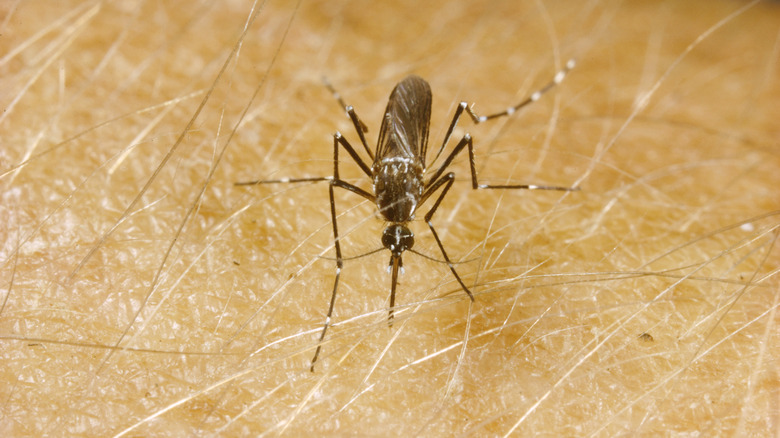Why Mosquitoes Always Bite Your Ankles First
You're spending a relaxing summer evening outdoors when suddenly, you feel the dreaded prick of a mosquito bite upon your skin. If we had to guess, odds are that first bite of the night was planted right on your ankles. Our ankles aren't exactly the fleshiest part of the body for a mosquito to munch on, so what is it about this particular area that's so alluring to these irritating insects?
Exposed skin makes it easy for female mosquitoes to stick their mouthparts into human flesh and feed on our blood. Once they do so, saliva gets deposited into our bloodstream, according to the U.S. Centers for Disease Control and Prevention (CDC). This prompts the emergence of a red, itchy bump. Even if you're wearing long sleeves and long pants to protect yourself, if your pant legs slide up when you sit down, that mosquito has its opening. But there's another reason as to why mosquitoes tend to be drawn to our ankles first, and it has nothing to do with whether or not your ankles are covered. Rather, it has everything to do with the smell of our feet.
Mosquitoes are attracted to foot odor
Our feet elicit an odor that is particularly enticing to mosquitoes. "One thing scientists have known for a long time is that mosquitoes are attracted to the odor of used gym socks," Dr. Jon Oliver of the University of Minnesota told KFVS12. "They are being attracted to that kind of mix of bacteria and fungus that causes foot odor. That's why mosquitoes often bite people on their feet and ankles."
While various regions of the body will give off their own unique scents, our feet are among the most pungent. Therefore, it doesn't take long for a mosquito to sniff them out. Not only that, but mosquitoes are keen as to which areas of the human body are a safer bet for an uninterrupted meal than others (via NPR). A mosquito is much more likely to get waved off by a human hand if they were to land squarely on our nose versus down by our unsuspecting ankles. As a result, they've learned how to pinpoint these safer areas through smell.
You may be dealing with ankle-biter mosquitoes
In September 2022, CBS Los Angeles reported that an influx of Aedes aegypti mosquitoes, or "ankle-biter" mosquitoes, had been detected as far south as San Diego. Although the invasive species has existed in California for more than a decade, these white-striped critters behave much differently than other mosquitoes in the region. They're less dependent on water, you can find them out and about during the daytime, and they'll bite over and over again. Drawn to shade and with limited flying ability, these mosquitoes stay close to the ground as well as our ankles. Because Aedes aegypti mosquitoes thrive in warm, humid environments, 2017 data from the U.S. Centers for Disease Control and Prevention (CDC) estimate that this species of mosquito could potentially live and reproduce in different regions of the country, predominantly along the west coast and southern states.
Diseases such as yellow fever, Zika, and dengue have been seen in connection with Aedes aegypti mosquitoes. While the presence of these mosquitoes had not been deemed an emergency, experts did emphasize the importance of using DEET-containing insect repellent throughout the autumn months. Additionally, San Diego County officials note that Aedes aegypti mosquitoes only need one-quarter inch of water in which to lay their eggs. Therefore, you'll want to keep your home and yard clear of standing water, which will help keep any and all kinds of mosquitoes at bay.



